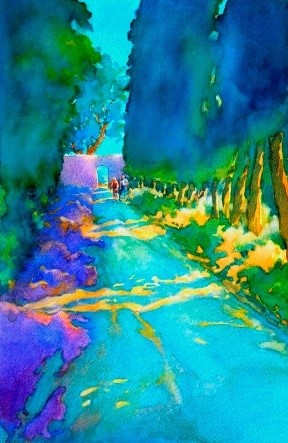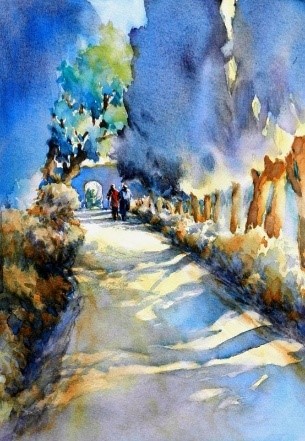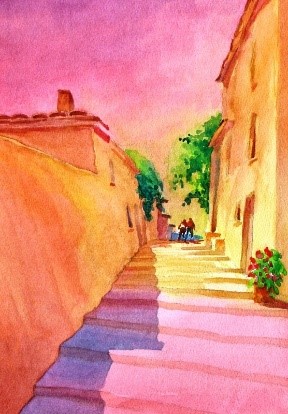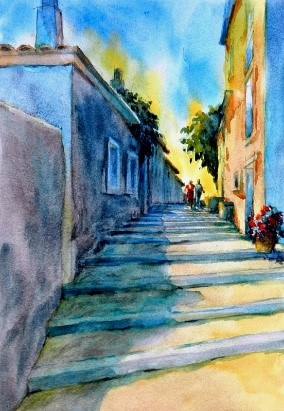Interested in an Original Painting?
Contact Virgil to inquire.
Interested in fine art prints and
more? Shop Fine Art America

“Hill Country Skies, No 1”, Watercolor, 11” X 15”
![]() 15 June 2025
15 June 2025
Painting the same or similar subject more than once isn’t about redundancy—it’s about revelation. Each version offers a new lens, mood, or story. It’s a practice of deepening connection, refining technique, and exploring emotional nuance.
What Changes Each Time?
• Mood: A rainy day version may feel wistful; a sunlit one, joyful.
• Color Palette: Cool tones evoke quiet; warm tones energize.
• Composition: Cropping, scale, and negative space shift the narrative.
• Technique: Wet-on-wet softness vs. crisp drybrush detail.
• Intention: What do you want to say this time?
The Value of Variation
• Creative Growth: Each iteration builds skill and insight.
• Emotional Exploration: Different moods reveal different truths.
• Personal Voice: Repetition helps you discover what feels most “you.”
Exercises to Explore Variation
1. Three Takes: Paint the same subject with three different emotional intentions (e.g., peaceful, tense, nostalgic).
2. Technique Swap: Use a different watercolor technique for each version—layering, lifting, splattering, etc.
3. Time Shift: Paint the subject as if seen at dawn, midday, and dusk.
Reflective Prompts
• What surprised me in this version?
• How did my choices shift with mood or intention?
• What does each version reveal about my relationship to the subject?
Part Two:
The Power of Painting the Same or Similar Subject Differently with Watercolor
Watercolor painting offers a unique opportunity to explore the same or similar subject from multiple angles, each time uncovering a new story or emotion. Exploring a subject multiple times through watercolor painting—each time telling a different story—offers profound artistic and personal value. This practice not only sharpens technical skill but also deepens narrative capacity, enriches emotional expression, and fosters creative growth. And, just as important, it offers viewers the opportunity to engage with a series of experiences and emotions.



This first series example, “Hill Country” series, is an approach to painting the Texas Hill Country where I live and paint—each piece tells a distinct story through mood, composition, color and technique.
• “Hill Country Skies, No 1”: This piece captures the vastness and drama of the sky, with expressive brushwork and a dynamic interplay of light and shadow. The movement in the clouds suggests a fleeting moment, emphasizing the ever-changing nature of the landscape.
• “Hill Country Skies, No 2”: While still focused on the sky, this painting leans into warmth and contrast. The golden hues create a sense of tranquility and nostalgia, evoking the feeling of a sunset or early morning glow. The balance between cool and warm tones adds depth and emotion.
• “Hill Country Abstract, No 6”: This piece takes a more interpretive approach, distilling the essence of the Hill Country into abstract forms and colors. It moves away from direct representation and instead explores the emotional resonance of the landscape, inviting viewers to engage with the scene in a more personal, intuitive way. As someone said, “The silence is deafening!”
Together, these paintings showcase the ability to shift between realism and abstraction, using watercolor to evoke different moods and narratives. Do you find yourself drawn more to the structured storytelling of the skies or the expressive freedom of abstraction?


In our second example, the ” Morning Breaks-Last Light” series are two paintings which capture the essence of the Texas Hill Country but evoke different moods through light and atmosphere.
• “Hill Country Morning Breaks, No 1”: This piece focuses on the transformative power of morning light. The soft, golden hues suggest the quiet emergence of the day, with light filtering through the landscape in a way that feels both intimate and expansive. The brushwork and color choices emphasize freshness and renewal, making the scene feel alive with possibility.
• “Hill Country Last Light, No 1”: In contrast, this painting explores the fading glow of the day. The colors likely lean toward deeper, richer tones, reflecting the warmth and nostalgia of the setting sun. There’s a sense of closure and reflection, as the landscape settles into the evening. The interplay of light and shadow might create a more dramatic or contemplative mood.
Together, these paintings showcase the ability to use light as a storytelling element, shifting between the optimism of morning and the quiet introspection of dusk. Do you find yourself drawn more to the energy of sunrise or the serenity of twilight in these paintings?
Finally, the two series, “Between the Shadows and the Light”, and ” Vaugines Steps” each explores the delicate interplay of illumination and obscurity, capturing fleeting moments of atmosphere and mood.




These paintings convey the many different moods when each conveys a different story.
• “Between the Shadows and the Light, No 2”: This watercolor painting focuses on the effects of deep shadows on a picturesque back road in Lourmarin, Provence, France. The composition emphasizes the contrast between warm, golden light and the deepening shadows, creating a sense of depth and movement. The choice of colors and brushwork suggests a tranquil yet dynamic scene, where light filters through the landscape in a way that feels both intimate and expansive.
• “Between the Shadows and the Light, No 3”: This watercolor painting continues the theme of exploring light and shadow, with a different perspective or emotional tone. If No 2 captures the warmth of deep shadows, No 3 shifts toward a cooler, more introspective interpretation—emphasizing the mystery of shadows or the fleeting nature of light.
The “Vaugines Steps” paintings capture the charm and history of Vaugines, a small hillside town in Provence, France.
• “Vaugines Steps, No 1”: This watercolor painting highlights the warm, vibrant colors of the town’s narrow streets and traditional stone buildings. The composition steps down a hill, leading the viewer’s eye through the scene, where a distant couple adds life and movement. The lush greenery and flowers contrast beautifully with the pink sky, creating a sense of warmth and nostalgia.
• “Vaugines Steps, No 2”: This watercolor painting continues the theme of capturing the essence of Vaugines, with a different perspective or lighting. If No 1 emphasizes warmth and vibrancy, No 2 explores a cooler or more atmospheric interpretation—focusing on shadow, texture, or a different time of day.
Painting the same or similar subjects in watercolor, each with a different story, is a powerful practice of painterly intent that yields technical mastery, narrative richness, emotional depth, and creative vitality. It transforms repetition into revelation, allowing both artist and viewer to experience the familiar anew, and to discover the endless stories that lie within a single subject when seen through the ever-changing lens of painterly intent.
Together, these paintings showcase the ability to tell a wide range of stories using the same or similar subjects. And painting the same or similar subjects offers viewers the opportunity to discover a range of emotions and ideas.
Have you considered and used the power of the same or similar subjects?
Contact Virgil to inquire.
more? Shop Fine Art America

“You Must Go Left or Right” , Watercolor, 30” X 11”